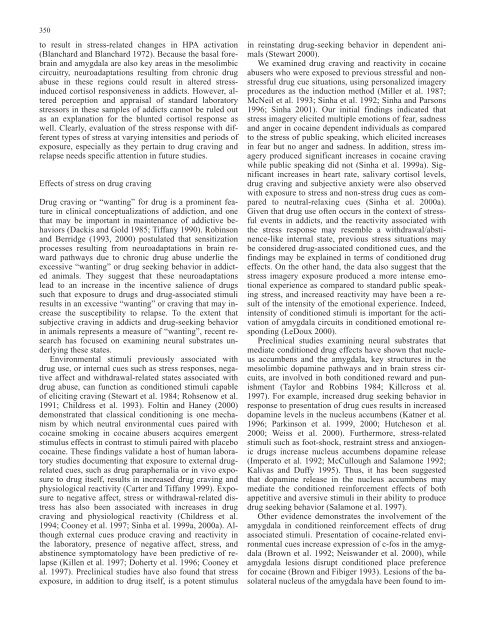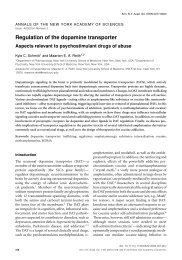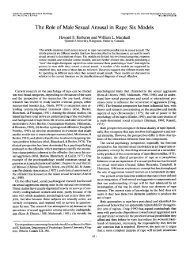How does stress increase risk of drug abuse - Addiction Research ...
How does stress increase risk of drug abuse - Addiction Research ...
How does stress increase risk of drug abuse - Addiction Research ...
Create successful ePaper yourself
Turn your PDF publications into a flip-book with our unique Google optimized e-Paper software.
350<br />
to result in <strong>stress</strong>-related changes in HPA activation<br />
(Blanchard and Blanchard 1972). Because the basal forebrain<br />
and amygdala are also key areas in the mesolimbic<br />
circuitry, neuroadaptations resulting from chronic <strong>drug</strong><br />
<strong>abuse</strong> in these regions could result in altered <strong>stress</strong>induced<br />
cortisol responsiveness in addicts. <strong>How</strong>ever, altered<br />
perception and appraisal <strong>of</strong> standard laboratory<br />
<strong>stress</strong>ors in these samples <strong>of</strong> addicts cannot be ruled out<br />
as an explanation for the blunted cortisol response as<br />
well. Clearly, evaluation <strong>of</strong> the <strong>stress</strong> response with different<br />
types <strong>of</strong> <strong>stress</strong> at varying intensities and periods <strong>of</strong><br />
exposure, especially as they pertain to <strong>drug</strong> craving and<br />
relapse needs specific attention in future studies.<br />
Effects <strong>of</strong> <strong>stress</strong> on <strong>drug</strong> craving<br />
Drug craving or “wanting” for <strong>drug</strong> is a prominent feature<br />
in clinical conceptualizations <strong>of</strong> addiction, and one<br />
that may be important in maintenance <strong>of</strong> addictive behaviors<br />
(Dackis and Gold 1985; Tiffany 1990). Robinson<br />
and Berridge (1993, 2000) postulated that sensitization<br />
processes resulting from neuroadaptations in brain reward<br />
pathways due to chronic <strong>drug</strong> <strong>abuse</strong> underlie the<br />
excessive “wanting” or <strong>drug</strong> seeking behavior in addicted<br />
animals. They suggest that these neuroadaptations<br />
lead to an <strong>increase</strong> in the incentive salience <strong>of</strong> <strong>drug</strong>s<br />
such that exposure to <strong>drug</strong>s and <strong>drug</strong>-associated stimuli<br />
results in an excessive “wanting” or craving that may <strong>increase</strong><br />
the susceptibility to relapse. To the extent that<br />
subjective craving in addicts and <strong>drug</strong>-seeking behavior<br />
in animals represents a measure <strong>of</strong> “wanting”, recent research<br />
has focused on examining neural substrates underlying<br />
these states.<br />
Environmental stimuli previously associated with<br />
<strong>drug</strong> use, or internal cues such as <strong>stress</strong> responses, negative<br />
affect and withdrawal-related states associated with<br />
<strong>drug</strong> <strong>abuse</strong>, can function as conditioned stimuli capable<br />
<strong>of</strong> eliciting craving (Stewart et al. 1984; Rohsenow et al.<br />
1991; Childress et al. 1993). Foltin and Haney (2000)<br />
demonstrated that classical conditioning is one mechanism<br />
by which neutral environmental cues paired with<br />
cocaine smoking in cocaine <strong>abuse</strong>rs acquires emergent<br />
stimulus effects in contrast to stimuli paired with placebo<br />
cocaine. These findings validate a host <strong>of</strong> human laboratory<br />
studies documenting that exposure to external <strong>drug</strong>related<br />
cues, such as <strong>drug</strong> paraphernalia or in vivo exposure<br />
to <strong>drug</strong> itself, results in <strong>increase</strong>d <strong>drug</strong> craving and<br />
physiological reactivity (Carter and Tiffany 1999). Exposure<br />
to negative affect, <strong>stress</strong> or withdrawal-related di<strong>stress</strong><br />
has also been associated with <strong>increase</strong>s in <strong>drug</strong><br />
craving and physiological reactivity (Childress et al.<br />
1994; Cooney et al. 1997; Sinha et al. 1999a, 2000a). Although<br />
external cues produce craving and reactivity in<br />
the laboratory, presence <strong>of</strong> negative affect, <strong>stress</strong>, and<br />
abstinence symptomatology have been predictive <strong>of</strong> relapse<br />
(Killen et al. 1997; Doherty et al. 1996; Cooney et<br />
al. 1997). Preclinical studies have also found that <strong>stress</strong><br />
exposure, in addition to <strong>drug</strong> itself, is a potent stimulus<br />
in reinstating <strong>drug</strong>-seeking behavior in dependent animals<br />
(Stewart 2000).<br />
We examined <strong>drug</strong> craving and reactivity in cocaine<br />
<strong>abuse</strong>rs who were exposed to previous <strong>stress</strong>ful and non<strong>stress</strong>ful<br />
<strong>drug</strong> cue situations, using personalized imagery<br />
procedures as the induction method (Miller et al. 1987;<br />
McNeil et al. 1993; Sinha et al. 1992; Sinha and Parsons<br />
1996; Sinha 2001). Our initial findings indicated that<br />
<strong>stress</strong> imagery elicited multiple emotions <strong>of</strong> fear, sadness<br />
and anger in cocaine dependent individuals as compared<br />
to the <strong>stress</strong> <strong>of</strong> public speaking, which elicited <strong>increase</strong>s<br />
in fear but no anger and sadness. In addition, <strong>stress</strong> imagery<br />
produced significant <strong>increase</strong>s in cocaine craving<br />
while public speaking did not (Sinha et al. 1999a). Significant<br />
<strong>increase</strong>s in heart rate, salivary cortisol levels,<br />
<strong>drug</strong> craving and subjective anxiety were also observed<br />
with exposure to <strong>stress</strong> and non-<strong>stress</strong> <strong>drug</strong> cues as compared<br />
to neutral-relaxing cues (Sinha et al. 2000a).<br />
Given that <strong>drug</strong> use <strong>of</strong>ten occurs in the context <strong>of</strong> <strong>stress</strong>ful<br />
events in addicts, and the reactivity associated with<br />
the <strong>stress</strong> response may resemble a withdrawal/abstinence-like<br />
internal state, previous <strong>stress</strong> situations may<br />
be considered <strong>drug</strong>-associated conditioned cues, and the<br />
findings may be explained in terms <strong>of</strong> conditioned <strong>drug</strong><br />
effects. On the other hand, the data also suggest that the<br />
<strong>stress</strong> imagery exposure produced a more intense emotional<br />
experience as compared to standard public speaking<br />
<strong>stress</strong>, and <strong>increase</strong>d reactivity may have been a result<br />
<strong>of</strong> the intensity <strong>of</strong> the emotional experience. Indeed,<br />
intensity <strong>of</strong> conditioned stimuli is important for the activation<br />
<strong>of</strong> amygdala circuits in conditioned emotional responding<br />
(LeDoux 2000).<br />
Preclinical studies examining neural substrates that<br />
mediate conditioned <strong>drug</strong> effects have shown that nucleus<br />
accumbens and the amygdala, key structures in the<br />
mesolimbic dopamine pathways and in brain <strong>stress</strong> circuits,<br />
are involved in both conditioned reward and punishment<br />
(Taylor and Robbins 1984; Killcross et al.<br />
1997). For example, <strong>increase</strong>d <strong>drug</strong> seeking behavior in<br />
response to presentation <strong>of</strong> <strong>drug</strong> cues results in <strong>increase</strong>d<br />
dopamine levels in the nucleus accumbens (Katner et al.<br />
1996; Parkinson et al. 1999, 2000; Hutcheson et al.<br />
2000; Weiss et al. 2000). Furthermore, <strong>stress</strong>-related<br />
stimuli such as foot-shock, restraint <strong>stress</strong> and anxiogenic<br />
<strong>drug</strong>s <strong>increase</strong> nucleus accumbens dopamine release<br />
(Imperato et al. 1992; McCullough and Salamone 1992;<br />
Kalivas and Duffy 1995). Thus, it has been suggested<br />
that dopamine release in the nucleus accumbens may<br />
mediate the conditioned reinforcement effects <strong>of</strong> both<br />
appetitive and aversive stimuli in their ability to produce<br />
<strong>drug</strong> seeking behavior (Salamone et al. 1997).<br />
Other evidence demonstrates the involvement <strong>of</strong> the<br />
amygdala in conditioned reinforcement effects <strong>of</strong> <strong>drug</strong><br />
associated stimuli. Presentation <strong>of</strong> cocaine-related environmental<br />
cues <strong>increase</strong> expression <strong>of</strong> c-fos in the amygdala<br />
(Brown et al. 1992; Neiswander et al. 2000), while<br />
amygdala lesions disrupt conditioned place preference<br />
for cocaine (Brown and Fibiger 1993). Lesions <strong>of</strong> the basolateral<br />
nucleus <strong>of</strong> the amygdala have been found to im-










